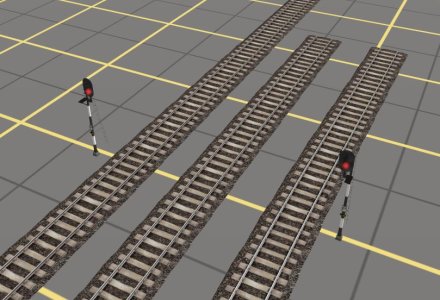Remember, in UK practice at least, multiple track spacing is not even. A pair of tracks have a "6-foot" between them, which is more or less a track spacing of 3.5m in Trainz. Any other track (or pair of tracks with their own 6-ft) must have a "10-foot" spacing from this pair - I use a 5m spacer in Trainz.
For those of you who understand German or are prepared to risk a translator, you can download the following from
www.ot2007.de
tb_qtw_A02_60 - Quertragwerk für 2 Gleise, 12m Mast, Ausführung A (kuid:42778:11558)
tb_qtw_A03_60 - Quertragwerk für 3 Gleise, 12m Mast, Ausführung A (kuid:42778:11557)
tb_qtw_A04_60 - Quertragwerk für 4 Gleise, 12m Mast, Ausführung A (kuid:42778:11550)
tb_qtw_A05_60 - Quertragwerk für 5 Gleise, 12m Mast, Ausführung A (kuid:42778:11551)
tb_qtw_A06_60 - Quertragwerk für 6 Gleise, 14m Mast, Ausführung A (kuid:42778:11552)
tb_qtw_A07_60 - Quertragwerk für 7 Gleise, 15m Mast, Ausführung A (kuid:42778:11553)
tb_qtw_A08_60 - Quertragwerk für 8 Gleise, 16m Mast, Ausführung A (kuid:42778:11554)
tb_qtw_A09_60 - Quertragwerk für 9 Gleise, 16m Mast, Ausführung A (kuid:42778:11555)
tb_qtw_A10_60 - Quertragwerk für 10 Gleise, 18m Mast, Ausführung A (kuid:42778:11556)
They can be found under:
FREE DOWNLOADS/
Das "neue" Fahrleitungssystem von Trainbernd und OpAmp/
Quertragwerke für Trainz
then 'Datei Herunterladen'
You need to download the following two files separately: (Each time you will have to correctly enter the puzzle letters to download)
http://www.ot2007.de/WDL/ol/Quertragwerke_6.0m_1.5.cdp - the objects
http://www.ot2007.de/WDL/ol/B07-Quertragwerke- 1.4.1.pdf . the instructions - in German only as far as I know, but to just use them for track spacing should be obvious enough after pressing the '?' in Surveyor
They are actually the catenary masts used for spanning multiple tracks, but they have markers for each track position. They can be customized to have variable spacings between each track between approx. 3.5m and 6m. ie a mix and match track spacing.
I hope these are of help to some of you

Regards
Mike


